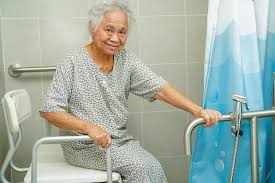As our loved ones age, ensuring their home remains a comfortable and safe environment becomes paramount. Proper home modifications can enhance their quality of life, allowing them to maintain independence while minimizing risks. This article explores practical steps to make a home senior-friendly, including investing in companion care and upgrading bathroom facilities.
Evaluate and Improve Home Accessibility
Creating a safe living space begins with assessing and improving home accessibility. Seniors often face mobility challenges that require thoughtful adjustments to their living environment.
- Entryway Modifications: One of the first areas to address is the entryway. Adding ramps or handrails can make entering and exiting the home easier for seniors with mobility issues. For homes with stairs, consider installing a ramp or lift to ensure safe and easy access.
- Widening Doorways and Hallways: For seniors who use wheelchairs or walkers, wide doorways and hallways are essential. Widening these areas allows for smoother movement and reduces the risk of accidents.
- Eliminate Tripping Hazards: Falls are a significant concern for seniors. To prevent tripping hazards, remove loose rugs and clutter, and use non-slip mats on slippery surfaces. Ensuring that floors are level and free of obstacles can greatly reduce the risk of falls.
Invest in Companion Care for Seniors
Companion care is a valuable option for enhancing the comfort and well-being of seniors. It goes beyond basic assistance, offering emotional support, and helping with daily tasks.
- What is Companion Care?: Companion care provides support through social interaction, assistance with daily activities, and help with medication management. It aims to improve the senior’s overall quality of life by addressing both physical and emotional needs.
- How Companion Care Enhances Comfort: Having a companion can alleviate feelings of loneliness and isolation, which are common among seniors. A companion can assist with tasks such as meal preparation, light housekeeping, and transportation to appointments, making daily life easier and more enjoyable.
- In-Home vs. Part-Time Companion Care: Depending on individual needs, companion care can be either full-time or part-time. Full-time care offers continuous support, while part-time care provides flexibility and can be tailored to specific needs.
For top-notch services, Check out Right at Home for the best companion care services in winnipeg to ensure your loved one receives the best support.
Optimize Lighting for Safety
Proper lighting is crucial for preventing accidents and ensuring a safe environment for seniors.
- Install Motion-Sensor Lighting: Motion-activated lights in hallways, entryways, and staircases can significantly reduce the risk of falls during the night. These lights automatically turn on when movement is detected, providing illumination without the need to fumble for switches.
- Use Soft, Bright Lighting: Bright but soft lighting reduces glare and improves visibility, which is especially helpful for seniors with vision impairments. Adequate lighting in commonly used areas such as the kitchen, living room, and bathroom is essential.
- Night Lights for Bathroom and Bedroom: Installing night lights in the bathroom and bedroom ensures safe navigation during nighttime trips, helping seniors avoid accidents in the dark.
Add Senior-Friendly Bathtubs and Showers
Bathroom modifications are essential for senior safety, as traditional tubs and showers can pose significant risks.
- Why Senior Bathtubs Are Important: Standard bathtubs can be hazardous for seniors, especially when getting in and out. Senior-friendly bathtubs are designed with safety features to prevent slips and falls, such as built-in seats, grab bars, and non-slip surfaces.
- Features of Senior Bathtubs: Walk-in tubs are a popular option, offering easy access and safety features like low thresholds and handrails. These bathtubs are designed to minimize the risk of falls and make bathing a more comfortable experience.
- Shower Modifications for Seniors: Roll-in showers with hand-held showerheads and anti-scald devices are ideal for seniors. These modifications allow for easier entry and exit, and the hand-held showerhead provides flexibility and convenience.
For high-quality senior bathtubs, visit Safe Bathing for seniors bathtubs for sale to find options that best suit your needs.
Create a Comfortable Living Space
Making a home comfortable for seniors involves more than just safety; it also requires creating a pleasant and functional living environment.
- Ergonomic Furniture for Seniors: Choose furniture that offers adequate support and is easy to get in and out of. Reclining chairs and adjustable beds are excellent choices that provide comfort and convenience.
- Arrange Furniture for Easy Movement: Organize the living space to allow for easy navigation, especially for seniors using mobility aids. Ensure that there is ample space to maneuver around furniture and other obstacles.
Install Safety Devices Throughout the Home
Safety devices are critical for enhancing home security and preventing accidents.
- Grab Bars and Handrails: Install grab bars in the bathroom, near staircases, and in hallways to provide support and stability. Handrails offer additional assistance for navigating stairs and uneven surfaces.
- Medical Alert Systems: A medical alert system or wearable device can be crucial in emergencies. It allows seniors to call for help quickly if needed.
- Smoke Detectors and Carbon Monoxide Alarms: Ensure that smoke detectors and carbon monoxide alarms are installed and functioning correctly. Regularly check these devices to maintain safety.
Conclusion
Creating a comfortable and safe home for seniors involves a combination of thoughtful modifications and supportive care. By improving accessibility, investing in companion care, optimizing lighting, and upgrading bathroom facilities, you can ensure that your loved ones remain comfortable and secure. Remember, these adjustments not only enhance safety but also promote independence and overall well-being.

